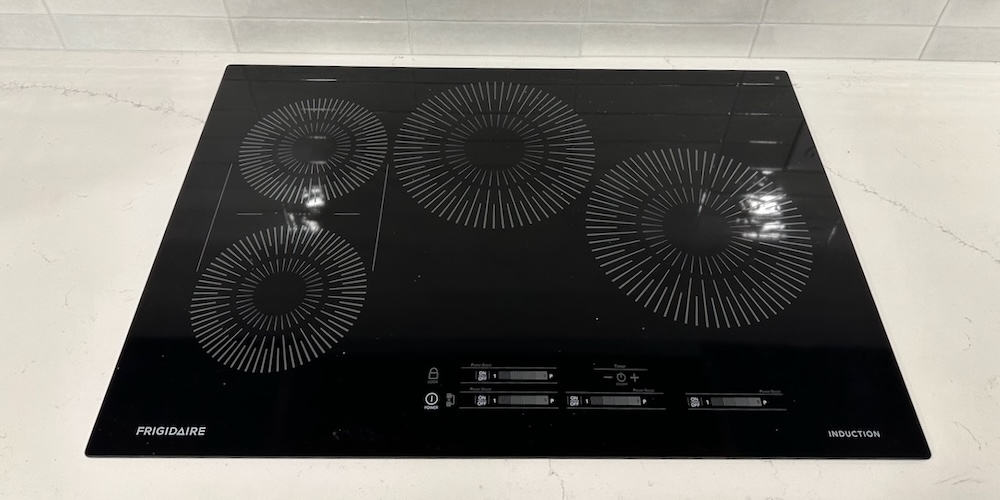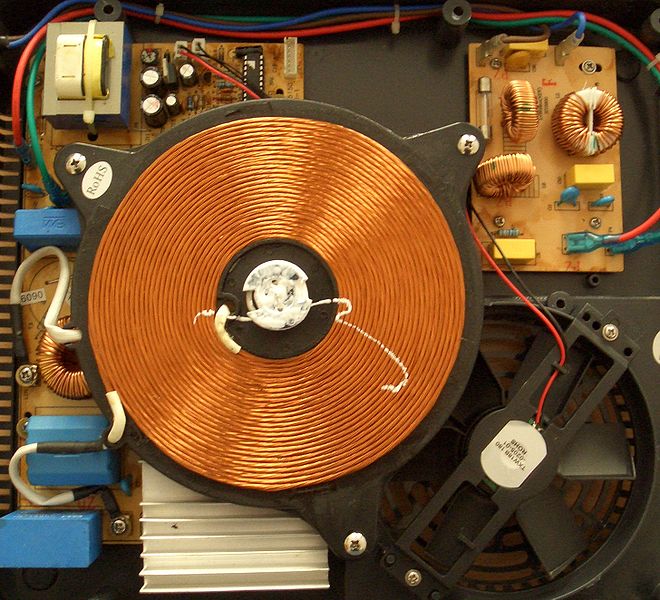A Pi Day Physics Lesson on the Induction Cooktop — With Dancing!

Today is Pi Day, named for that special number, 3.14159265358979323846264338327950288… The three dots at the end mean that I’ve exhausted my memory of the digits of pi, but pi doesn’t care. It just goes on and on. Anyway, Pi Day is a perfect day for a physics lesson because so many physics equations (and solutions) use that special number. And what better physics lesson for Pi Day than one about a device that cooks yummy things for us!
It seems like everywhere I go lately I hear about how if you want the best possible indoor air quality, you should use an induction cooktop. (Maybe if I stopped stalking Iain Walker, that wouldn’t happen so much.) Also, they’re about the most energy efficient way to cook. Alex Wilson, the green guru of Environmental Building News, just this week wrote an article about induction cooktops and why he chose one for his big renovation. He did a good job explaining the physics behind them, too, but I think I can add a bit to what he said…and even tie it in with some dancing, too!
Michael Faraday was the Steve Jobs of 19th century physics
 Michael Faraday was born to a family that wasn’t well off. He pretty much taught himself everything he knew and got into the Royal Institution by impressing some folks, especially Sir Humphry Davy, with his smarts. Davy hired him as a secretary, promoted him to Chemical Assistant. But Faraday was not a gentleman, in the English sense, and had to serve as Davy’s valet on a tour of the continent.
Michael Faraday was born to a family that wasn’t well off. He pretty much taught himself everything he knew and got into the Royal Institution by impressing some folks, especially Sir Humphry Davy, with his smarts. Davy hired him as a secretary, promoted him to Chemical Assistant. But Faraday was not a gentleman, in the English sense, and had to serve as Davy’s valet on a tour of the continent.
In other words, Faraday did whatever he had to do to advance his ideas. And he had plenty of them. By the end of his career, he’d made more big discoveries in physics and chemistry than the great majority of scientists who have ever lived. He’s right up there with Newton and Einstein.
Every time you turn on a blender or a fan or your car, you can thank him for his law of electromagnetic induction, also known as Faraday’s Law. It’s so important that it’s one of the four equations that compose Maxwell’s Equations, which tell you pretty much everything you need to know about electromagnetism.
“She made me do it!”
Induction means something is being induced. You know, like when you’re a kid and you get in trouble for setting that field on fire, and you explain to your mom, “But she† made me do it.” Except that in the case of electromagnetic induction, she really did. She, here, would be a changing magnetic field.
Take a magnet, especially a strong one like those little neodymium magnets, and wave it near a piece of copper. You’ll induce a voltage in the copper. The voltage will get the electrons moving. Another neat thing about electric current is that it creates its own magnetic field. So a changing magnetic field can create an electric current, which creates another magnetic field.
Wouldn’t it be cool if the induced current created a magnetic field that opposed the original magnetic field. Magnets have north and south poles, right? If you put two north poles together or two south poles together, they repel each other. As it turns out, the induced magnetic field does oppose the original magnetic field. (That’s called Lenz’s Law, by the way.)
So, going back to the magnet and copper idea, if that copper happens to be in a tube shape, and the neodymium magnet drops down inside it, the current will create a magnetic field that puts north against north, south against south, and will act against gravity to slow down the magnet’s fall. Just like you see in this video:
Wow! Now that is cool! Lenz’s Law doesn’t really have much to do with induction cooktops, but hey, it’s Pi Day and we’re having fun with physics here. The fact that the changing magnetic field sets up those electric currents in the copper pipe is what’s important. An induction cooktop does the same thing. I just wouldn’t trust the opposing magnetic field to slow your pot down if it falls off the stove.
Here’s another cool video that gives you a bit more background on Faraday’s Law.
Let’s call them Faraday cooktops
Back to the original topic now, induction cooktops. Under the ceramic top that you put the pots and pans on are electromagnets, coils of copper wire that produce magnetic fields when electric current runs through them (photo below). The key to Faraday’s Law is a changing magnetic field, and an alternating current does that for us nicely.
As the alternating current through that coil sets up the changing magnetic field, the pots and pans on the cooktop feel an induced voltage and the electrons start moving. When you put the right kind of metal pan on the stove, the kind with good magnetic properties, the pan responds with electric currents. The electrical resistance in the metal pan then turns that energy into heat.
The pan gets hot. The cooktop doesn’t, except by conduction from the pan downward. So all the electrical energy that goes into the cooktop turns into heat in the pan itself. You get minimal heat loss and high energy efficiency.
Another way to think of it is that this induction thing is kinda like when one person starts dancing and then others are moved to join in, kinda like in the video above.
Allison A. Bailes III, PhD is a speaker, writer, building science consultant, and the founder of Energy Vanguard in Decatur, Georgia. He has a doctorate in physics and is the author of a bestselling book on building science. He also writes the Energy Vanguard Blog. For more updates, you can subscribe to Energy Vanguard’s weekly newsletter and follow him on LinkedIn.
Footnote
† I use the feminine here not to make you think that I’m a woman but rather to inject some balance in my use of pronouns. If I wanted to make you think I were a woman I’d just tell you that my name is Allison, which it is, and that I’m in Who’s Who of American Women – The Millennium Edition, which I am. Also, I used ‘she’ to throw off you off and make you think it might have been my sister who made me do it when in fact it was my neighbor Bubba, who is not a woman. Well, he wasn’t a woman—or even a girl—back then anyway. I have no idea what twists and turns his life may have taken after that fateful day when the fire truck came to put out our fire.
Related Articles
Recirculating Range Hoods — As Effective As Recirculating Toilets
Comments are closed.
This Post Has 12 Comments
Comments are closed.


You crack me up Allison, you
You crack me up Allison, you never fail to amuse and educate all at the same time.
Keep it up
This is as far as I remember.
This is as far as I remember…3.141592653589793238462643383279502884197169399375105820974944592307816406286 208998628034825342117067982148086513282306647093844609550582231725359408128481 117450284102701938521105559644622948954930381964428810975665933446128475648233 786783165271201909145648566923460348610454326648213393607260249141273724587006 606315588174881520920962829254091715364367892590360011330530548820466521384146 951941511609433057270365759591953092186117381932611793105118548074462379962749 567351885752724891227938183011949129833673362440656643086021394946395224737190 702179860943702770539217176293176752384674818467669405132000568127145263560827 785771342757789609173637178721468440901224953430146549585371050792279689258923 542019956112129021960864034418159813629774771309960518707211349999998372978049 951059731732816096318595024459455346908302642522308253344685035261931188171010 003137838752886587533208381420617177669147303598253490428755468731159562863882 353787593751957781857780532171226806613001927876611195909216420198938095257201 065485863278865936153381827968230301952035301852968995773622599413891249721775… 🙂
The thing I always loved
The thing I always loved about Maxwell’s equations is they apply to any “irrotational flow” of which water is a fine approximate example.
So you can build anything with water that you can build with electronics (it just gets a bit bigger and messes up the kitchen a lot).
Examples :
Voltage = Potential Difference = Water tower
Current = Rate of Flow = Current
Induction = angular momentum = whirlpool (or stirred coffee)
Capacitance = Energy Store = Diaphragm
So Allison – my challenge to you is to build a mobile phone using conventional kitchen utensils 😉
So if I was wearing a metal
So if I was wearing a metal watch – or my wife a metal bracelet, and our wrists were in close proximity to the “burner”, our wrists would heat up by induction? I won’t even consider what that would do to an LED watch – I was just thinking of the old fashioned mechanical watch my father used to wear.
Allison, your posts are
Allison, your posts are sometimes so irrational. 😉
“The first follower is what transforms a lone nut into a leader.” Sure brings the critical role of Facebook fans to light, eh?
“Today is Pi Day, named
“Today is Pi Day, named for that special number, 3.14159265358797323846264338327950288…”
Oops. That should be 89793, not 87973.
Carl C.:
Carl C.: Never is a strong word. I assume you didn’t take it out to very many decimal places.
Armando: You rock!
james f.: I would take you up on that challenge, but I’m still trying to perfect my Turbo Thermo-Encabulator Max.
stephen d.: That hadn’t occurred to me before, but yes, induction cooktops would be safer, too, not only from someone burning themselves but also from someone accidentally leaving a burner on and starting a fire or filling the house with gas.
Charles: Yeah, if you were wearing a watch made of an appropriate metal and you put it right there on the cooktop, it would get hot.
Mike M.: Yes, I’m totally irrational. My imaginary friends are always telling me that. ;~)
David F.: That was just a test to see if anyone was paying attention. ;~) Actually, I think there was a disconnect between my brain and my fingers because I never forget those 4 digits.
Pi calculated to 39 decimal
Pi calculated to 39 decimal places is enough to calculate the circumference of the universe to within the width of a hydrogen atom.
NASA keeps space stations and GPS satellites in precise location with only 15 or 16 digits of Pi. 3.14 serves the rest of us quite sufficiently.
And Happy Birthday to Albert Einstein!
It isn’t really a problem if
It isn’t really a problem if you wear a watch.
The induction effect falls off with field strength, and thus it falls off with distance. Your range hood only heats up a negligible amount, and likewise for your watch.
What’s more, the induction effect is also restricted to the area directly above the cooktop. If you try using a pot that’s larger than the coil, the water will start boiling from the area directly above the coil.
As you’re cooking, your hands will be moving in and out of the induction “cylinder”, so to speak. That will further reduce the heating effect.
Nice article and videos ab3,
Nice article and videos ab3, but you are missing a key point.
The induction heating in cooktops is NOT primarily due to induced eddy currents in conductors, but rather, due to the fact that flipping spins in ferromagnetic materials is often a lossy process.
That is, if you put a piece of iron in an AC magnetic field, a certain amount of heat is generated every time you flip the magnetic polarity of the iron back and forth. Do it at high frequency, and you can create a lot of heat.
This is why induction cooktops only work with pots and pans made of iron, or containing iron plates in their base.
Dale S.:
Dale S.: Good point, but in calculating the circumference of the universe, the uncertainty of the other variables would prevent ever knowing the answer to within the width of a hydrogen atom, no matter how many digits of pi we used. It’s fun to think about though.
Tom: Thanks for the extra clarification. The field strength actually falls off even faster than you say. Rather than just decreasing linearly with distance, it falls off with the square of the distance. So when you double the distance, the field is a quarter of its original strength. What this means, as you said, is that you’d really never have to worry about your watch heating up.
John C.: Ah, the question of how much of the heating is due to the induced eddy currents versus heating from the magnetic hysteresis in ferromagnetic materials. I probably should have gone into that part of the process, and now you’ve caused me to spend an hour searching for the answer. As is true of most online information, I find conflicting answers to the question. Clearly the hysteresis plays a role, though, because an induction cooktop is much more effective with ferromagnetic cookware. But the induced eddy currents certainly contribute. Do you have a good reference on this topic?
On an experimental level, the
On an experimental level, the watch thing is a non-issue. I was actually more curious about the field interfering with Wi-Fi or cell phone signals, but I tried it with digital and mechanical watches too. I left a cheaper digital watch on the cooktop (adjacent a pan smaller than the element, because the range won’t run without a pan, assumedly by measure of resistance in the coil). No effects noted. A metal watch on my wrist I couldn’t get to heat to the touch. Off my wrist, I got the watch band on the element (alongside a pan as before) to heat, but that took some work.
So far, with my cooktop, the most interesting experience has been leaving a potato masher flat on the bottom of a pan and seeing it heat up to the handle. So, just like electric or gas, all-metal utensils might heat up if left flat on the bottom of the heating pan.
No real answer yet on the cellular and Wi-Fi interference. I am waiting for access to good EMF and RF meters to test that, alongside the microwave. But I have not observed any difference on Speedtest.com with my desktop Wi-Fi, with either the microwave or the induction cooktop.